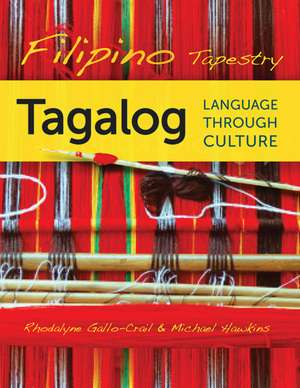Filipino Tapestry: Tagalog Language through Culture
Autor Rhodalyne Gallo-Crail, Michael Hawkinsen Limba Engleză Paperback – 24 feb 2012
An official language of the Philippines, Filipino is based on Tagalog, with elements of Spanish, English, and Chinese mixed in. The result is a rich, expressive language spoken in the Philippines and throughout the far-reaching Filipino diaspora.
Filipino Tapestry offers an innovative approach to learning language by emphasizing the critical intersection of language and culture. It provides activities and exercises that immerse beginning and intermediate students of Filipino in a variety of authentic situations to simulate an in-country experience. Starting with chapters on such topics as family, friends, and home, it then expands the student’s world in chapters prompting conversation about food, shopping, parties, and pastimes. Its later chapters push learners to discuss city and country life, cultural traditions, religion, history, and politics.
Features include:
• background chapters on phonology, sentence construction, and common expressions
• photos and cultural notes about chapter themes
• grammar, reading, listening, and speaking exercises
• glossaries of words and additional expressions
Filipino Tapestry offers an innovative approach to learning language by emphasizing the critical intersection of language and culture. It provides activities and exercises that immerse beginning and intermediate students of Filipino in a variety of authentic situations to simulate an in-country experience. Starting with chapters on such topics as family, friends, and home, it then expands the student’s world in chapters prompting conversation about food, shopping, parties, and pastimes. Its later chapters push learners to discuss city and country life, cultural traditions, religion, history, and politics.
Features include:
• background chapters on phonology, sentence construction, and common expressions
• photos and cultural notes about chapter themes
• grammar, reading, listening, and speaking exercises
• glossaries of words and additional expressions
Preț: 324.61 lei
Nou
Puncte Express: 487
Preț estimativ în valută:
62.13€ • 67.06$ • 52.09£
62.13€ • 67.06$ • 52.09£
Carte tipărită la comandă
Livrare economică 18 aprilie-02 mai
Preluare comenzi: 021 569.72.76
Specificații
ISBN-13: 9780299281649
ISBN-10: 0299281647
Pagini: 316
Ilustrații: 53 b-w illus., 1 map, 17 crossword puzzles
Dimensiuni: 216 x 279 x 15 mm
Greutate: 0.7 kg
Ediția:1
Editura: University of Wisconsin Press
Colecția University of Wisconsin Press
ISBN-10: 0299281647
Pagini: 316
Ilustrații: 53 b-w illus., 1 map, 17 crossword puzzles
Dimensiuni: 216 x 279 x 15 mm
Greutate: 0.7 kg
Ediția:1
Editura: University of Wisconsin Press
Colecția University of Wisconsin Press
Notă biografică
Rhodalyne Gallo-Crail teaches Tagalog at Northern Illinois University and speaks the language natively. She is the creator and director of the Tagalog website sponsored by NIU’s Center for Southeast Asian studies: http://www.seasite.niu.edu/Tagalog/. Michael Hawkins, who learned Tagalog by immersion in the Philippines, is assistant professor of Asian history at Creighton University.
Cuprins
Introduction
1. Pagbati (Greetings)
2. Pagsakay ng dyip (Riding a Jeepney)
3. Pamilya (Family)
4. Barkada (Friends)
5. Bahay (Home)
6. Pamamalengke (Going to Market)
7. Pagkain (Food)
8. Salu-salo (Parties)
9. Pagsamba (Religion)
10. Pista (Fiesta)
11. Aliwan (Pastimes)
12. Buhay sa bukid (Life in the Country)
13. Buhay sa siyudad (Life in the City)
14. Tradisyon (Traditions)
15. Pangingibang bansa (Working Abroad)
16. Kasaysayan (History)
17. Pulitika (Politics)
Vocabulary Glossary List by Chapter
1. Pagbati (Greetings)
2. Pagsakay ng dyip (Riding a Jeepney)
3. Pamilya (Family)
4. Barkada (Friends)
5. Bahay (Home)
6. Pamamalengke (Going to Market)
7. Pagkain (Food)
8. Salu-salo (Parties)
9. Pagsamba (Religion)
10. Pista (Fiesta)
11. Aliwan (Pastimes)
12. Buhay sa bukid (Life in the Country)
13. Buhay sa siyudad (Life in the City)
14. Tradisyon (Traditions)
15. Pangingibang bansa (Working Abroad)
16. Kasaysayan (History)
17. Pulitika (Politics)
Vocabulary Glossary List by Chapter
Descriere
An official language of the Philippines, Filipino is based on Tagalog, with elements of Spanish, English, and Chinese mixed in. The result is a rich, expressive language spoken in the Philippines and throughout the far-reaching Filipino diaspora.
Filipino Tapestry offers an innovative approach to learning language by emphasizing the critical intersection of language and culture. It provides activities and exercises that immerse beginning and intermediate students of Filipino in a variety of authentic situations to simulate an in-country experience. Starting with chapters on such topics as family, friends, and home, it then expands the student’s world in chapters prompting conversation about food, shopping, parties, and pastimes. Its later chapters push learners to discuss city and country life, cultural traditions, religion, history, and politics.
Features include:
• background chapters on phonology, sentence construction, and common expressions
• photos and cultural notes about chapter themes
• grammar, reading, listening, and speaking exercises
• glossaries of words and additional expressions
Filipino Tapestry offers an innovative approach to learning language by emphasizing the critical intersection of language and culture. It provides activities and exercises that immerse beginning and intermediate students of Filipino in a variety of authentic situations to simulate an in-country experience. Starting with chapters on such topics as family, friends, and home, it then expands the student’s world in chapters prompting conversation about food, shopping, parties, and pastimes. Its later chapters push learners to discuss city and country life, cultural traditions, religion, history, and politics.
Features include:
• background chapters on phonology, sentence construction, and common expressions
• photos and cultural notes about chapter themes
• grammar, reading, listening, and speaking exercises
• glossaries of words and additional expressions
